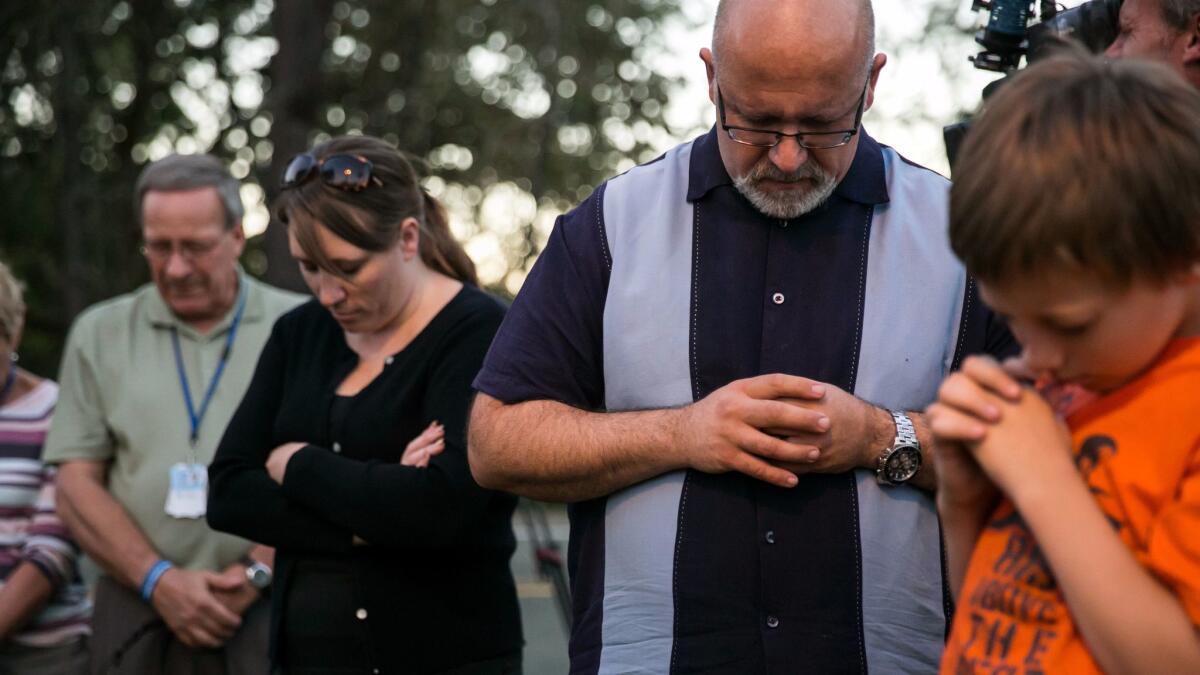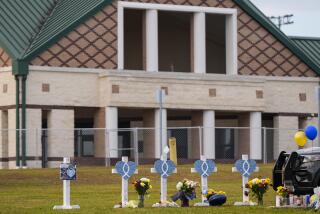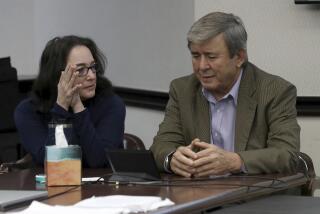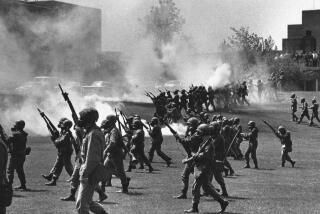‘Here I am, 26, with no friends, no job, no girlfriend’: Shooter’s manifesto offers clues to 2015 Oregon college rampage

Reporting from Seattle — Laurel Harper remembered her 26-year-old son as perpetually mad at the world.
“I mean, he was born angry, pretty much,” said the mother. “I mean, even the doctor said this is one angry baby.”
At age 5, he tried to jump out of her moving car, she said. In his later years, he was diagnosed with Asperger’s syndrome, which can limit social development and lead to behavioral meltdowns. He took medications but by age 18 gave them up because of side effects.
He continued to rage. “I would just try to, try to, like, defuse,” she said. “And there was one time when he pointed a shotgun at me.”
She calmly talked him down. She never called the police then or other times because she didn’t want him to go to jail.
“I was just too weak or something. I just couldn’t do it.”
When he was small and acting angrily, she would put him in a bear hug until he gave up, she recalled. Now, she felt, she had no solutions.
He owned nine guns, including an assault-style rifle, said Harper, a part-time night nurse at the county jail. She eventually joined him at the shooting range with her own AR-15, thinking it could be a healthy mother-son activity.
No, she told the two Oregon State Police detectives sitting in her living room and interviewing her that morning of Oct. 1, 2015, she didn’t know why Christopher Sean Harper-Mercer, in horn-rimmed glasses and shaved head brandishing several of six guns he brought along, killed all those people two hours earlier.
Most of the nine bodies were found in one classroom at Umpqua Community College in Roseburg, which he attended, and where he had herded frightened students for questioning. He asked some of them if they believed in God, then killed them one by one before shooting himself, according to newly released police records and interview transcripts.
Witnesses said Harper-Mercer told one student who said he was Catholic, “Thank you for standing for your beliefs,” then shot him. He told some of his victims that death wouldn’t hurt, and laughed as one died. Harper-Mercer killed 10 people that day — himself included — and wounded seven.
Why? the detectives asked. What made him snap?
“There’s nothing I could look back at and say, ‘Oh, yeah, this, there’s an arrow pointing the way’” to the Umpqua massacre, his mother told the detectives. “Nothing.”
But, in the wake of last week’s school shootings near Spokane, Wash., and other recent school-related shooting incidents across the U.S., some insights and similarities have emerged from a comparison of some of the cases. They reveal missed warning signs, shooters imitating and idolizing other shooters, and suggest that access to weapons was no problem for shooters, many who used their parents’ guns.
It is a pattern reflected in many of the 239 U.S. school shootings that have occurred since 2013, according to everytownresearch.org. Among the site’s findings from shootings perpetrated by minors at primary and secondary schools and for which the source of the firearm was known, more than half of the shooters obtained their weapons at home, probably because an adult did not store them locked and unloaded.
The release of the Umpqua shooting files, a week before the Spokane shooting, came almost two years after the Oregon incident, delayed in part because the FBI was investigating the mother for possible charges. None were filed, and officials declared that Harper-Mercer “acted alone.”
Most revealing in the files, however, was a copy of the shooter’s manifesto.
In it, Harper-Mercer seemed to have drawn up a script of his life to convince the public and media that the killings were the result of his mistreatment by others, and that he was merely seeking revenge. The journal also has the overly dramatic tone of someone seeking to be noticed.
“I have always been the most hated person in the world,” Harper-Mercer wrote. “Ever since I arrived in this world, I have been under siege from it. Under attack from morons and idiots.… My whole life has been one lonely enterprise. One loss after another. And here I am, 26, with no friends, no job, no girlfriend, a virgin. I long ago realized that society likes to deny people like me these things. People who are elite, people who stand with the gods.”
The people like him — the ones who stand with the gods — he said, were “Elliot Rodger, Vester Flanagan, the Columbine kids, Adam Lanza and Seung Cho.”
All are shooters that Harper-Mercer may have emulated.
-- In 2014, Rodger killed six people and injured 14 others near the campus of UC Santa Barbara, then shot himself. He had earlier uploaded a YouTube video called “Elliot Rodger’s Retribution” that claimed he sought to punish women for rejecting him and said he was jealous of sexually active men. He also wrote a manuscript, “My Twisted World,” that wound up on the Internet and was referred to as his manifesto.
-- Flanagan boldly killed two Virginia journalists – reporter Allison Parker and cameraman Adam Ward – on live television in 2015, then killed himself. Flanagan, who is black, claimed in a suicide note that the recent massacre of nine black worshipers at a South Carolina church by admitted white supremacist Dylann Roof was “the tipping point.… I’ve been a human powder keg for a while … just waiting to go BOOM!!!!”
--The “Columbine kids” refer to Eric Harris and Dylan Klebold, who killed 13 people and wounded 24 others in 1999 at Columbine High School in Colorado, then killed themselves. They used illegally acquired and altered semiautomatic weapons, plus a bomb that failed to detonate. A journal, or manifesto, found in Harris’ bedroom detailed their massacre plans, in which they hoped to “outdo” the violence of the Oklahoma City bombing and the Waco siege.
--In 2012, Adam Lanza shot his mother at home, killed 20 first-graders and six adults at Sandy Hook Elementary School in Newtown, Conn., then shot himself – 28 deaths in one day. Lanza, who had developmental and mental health concerns, posted writings and audio clips on a mass-killer website that was mostly devoted to the Columbine shooters. In one post, he wrote of how such killers were admired: “Just look at how many fans you can find for all different types of mass murderers and beyond these fans are countless more people who can sympathize with them.” He used his mother’s Bushmaster semiautomatic rifle and a handgun at the school. A report noted that “access to assault weapons with high capacity magazines did play a major role in this and other mass shootings in recent history.”
-- Seung-Hui Cho killed 32 people and wounded 17 others while armed with two semiautomatic pistols in 2007 at Virginia Tech University in Blacksburg, Va. Cho, who suffered from depression, had briefly been confined to a mental health facility but was nonetheless able to buy the two pistols from legit dealers, in violation of the law. In a postmortem report, educators and mental health professionals were criticized for failing to notice his deteriorating condition and help him. The report also criticized misinterpretations of privacy laws and gaps in Virginia’s mental health system and gun laws.
Though unmentioned in the manifesto, other recent cases show more similarities. Arcan Cetin, 20, for example, who randomly killed five people at a Burlington, Wash., mall last year, then later hanged himself in jail, obtained his weapons from the bedroom of his parents, whom he was visiting for dinner. Also, he apparently planned for a larger massacre, having propped open a door to a nearby movie theater -- but after finding it closed, took his rifle to a woman’s store in the mall instead. Investigators said Cetin’s theater plan was probably inspired by James E. Holmes’ Aurora, Colo., theater massacre in 2012 that left 12 dead and 70 wounded.
And 15-year-old freshman Jaylen Fryberg, who in 2014 shot five other students, four fatally, at Marysville Pilchuck High School north of Seattle before taking his own life, obtained his firearm from his father’s collection. Raymond Fryberg was later found guilty of owning nine firearms he legally could not possess and received a two-year prison sentence.
The Sept. 13 shooting at Freeman High School in Rockport, near Spokane, was allegedly the work of 15-year-old sophomore Caleb Sharpe, who, like Umpqua shooter Harper-Mercer, sports a shaved head and horn-rimmed glasses and has a deep dislike for other students. He told police he wanted to “teach everyone a lesson about what happens when you bully others,” according to probable-cause papers filed in court.
Using weapons (an assault-style semiautomatic rifle, which jammed, and a handgun that later jammed, both of which he took from his father’s gun safe), he allegedly killed a student who tried to stop him and then shot three others. When the handgun jammed, he raised his hands and surrendered to a school custodian, then was held for police
His parents were aware he knew the combination to the gun safe and said he had earlier threatened to take his own life, writing out his feelings in a suicide note, authorities said. A school counselor was also made aware of his depression, but no one took any action, police said.
Friends said Sharpe also had an obsession with other school shooters, and some classmates suspected he, too, might become one. Court papers say Sam Strahan, the teen student he killed, had approached him while he was loading the rifle in the school hallway and said, “I always knew you were going to shoot up the school. You know that is going to get you in trouble.” Strahan was then shot twice, once in the head.
In his recently released manifesto, Chris Harper-Mercer indicated he’d put in some time studying and critiquing mass shooters. “I noticed where they always go wrong is they don’t work fast enough and their death toll is not anywhere near where it should be. They shoot wildly instead of targeted blasts. They also don’t take on the cops. Why kill other people but you won’t take out the cops.” (Harper-Mercer did fire at police, but when they fired back, he killed himself.)
Douglas County Sheriff John Hanlin, whose agency investigated the Umpqua shooting, says school shooters in part are motivated by the notoriety they’re likely to receive. That’s why, to this day, he refuses to say Harper-Mercer’s name in public.
“You will never hear me mention his name,” Hanlin said. “I will not give him the credit he probably sought prior to this horrific and cowardly act.”
Indeed, Harper-Mercer made it clear he sought media notoriety, writing in his manifesto: “Now for the part I’m sure the media will love. My interests. My interests include listening to music, watching movies, internet piracy. My only solace in online life is posting on Kat.cr as the user lithium_love. I mostly have uploaded porno, ebooks, things like that. That has been my only joy in life.”
He included a dedication: “For all those who never took me seriously, this is for you. For all those who haven’t made their stand, I do this. I am the martyr for all those like me. To quote Seung Cho, ‘Today I die like Jesus Christ.’”
At least, he added, “my success in Hell is assured.”
To read the article in Spanish, click here
Anderson is a special correspondent.
ALSO
Oregon shooting victim Chris Mintz recounts ordeal, takes on conspiracy theorists
Oregon sheriff wrote, ‘Gun control is NOT the answer,’ and residents agree
‘Daddy, he began to shoot’: A daughter’s account of Oregon rampage
More to Read
Sign up for Essential California
The most important California stories and recommendations in your inbox every morning.
You may occasionally receive promotional content from the Los Angeles Times.









